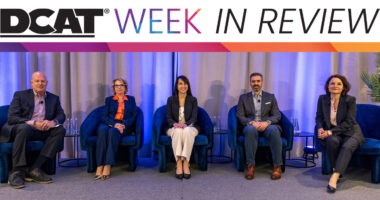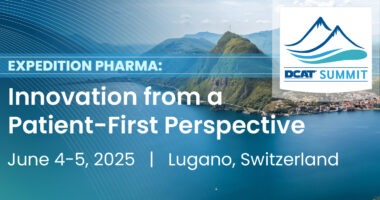Tracking the Market for Custom Synthesis
How are the fundamentals for the market for custom synthesis? DCAT Value Chain Insights (VCI) examines the key factors shaping the market and recent activity among fine-chemical producers and contract manufacturers.
The collective performance of the pharmaceutical industry is a key factor in the market for custom synthesis. And for the industry as a whole, 2014 showed increased strength, in part due to fewer patent expiries and greater productivity, which was reflected in a recent high in the number of approvals of new molecule entities (NMEs). Within the small-molecule sector, contract manufacturers are proceeding with select investments, such as in high-potency manufacturing, and for those contract manufacturers dually positioned in API and drug-product manufacturing, some are expanding capabilities in drug-product manufacturing, particularly for sterile manufacturing.
Sizing up the market
There are several positive trends in evaluating the near-term outlook of the global pharmaceutical market. A recent analysis by the IMS Institute for Healthcare Informatics projects that total global spending on medicines will reach $1.3 trillion in 2018, an increase between $290 billion and $320 billion from 2013, driven by population growth, an aging population, and improved access in pharmerging markets, a term IMS uses to denote emerging markets. Global spending growth on medicines is expected to increase between 4% and 7% through 2018. Global spending growth will peak in 2014-2015 and moderate through 2018 due to fewer patent expiries, launches of more innovative medicines, and prices increases, according to IMS.
In 2014, developed markets saw stronger growth due to fewer patent expiries, the launch of innovative medicines, and price increases, according to the IMS analysis. The greater contribution to growth from developed countries through 2018 is being led by the US and Japan, with France, Germany, Spain, the UK, and Italy maintaining relatively low growth levels. While these markets will moderate as cost-containment measures further limit price levels, rising volumes will continue to contribute to overall market growth, according to IMS. Among the major markets, the US remains the largest, representing one-third of the global pharmaceutical market. IMS projects a compound annual growth rate (CAGR) in the US pharmaceutical market of 5-8% through 2018, significantly higher than the 3.6% growth seen in the last forecast period of 2009-2013. IMS estimates show that US pharmaceutical market growth peaked in 2014 with growth of 11.7%, and the US market is expected to moderate beginning in 2015 to a CAGR of 5-8% and thereafter through 2018. This increase in growth is in part due to the reduced impact of generic-drug incursion and the launch of new products, producing what IMS calls a shift in the balance of the “innovation cycle” or the differential in the value of the amount of new medicines being launched and used compared to the value of branded medicines facing new generic competition.
Another positive sign for the US market in 2014 was the increase in the number of NMEs approved in 2014. The US Food and Drug Administration’s Center for Drug Evaluation and Research approved 41 NMEs in 2014, 30 new drug applications (i.e., small molecules) and 11 biologics license applications (BLAs), both recent highs in terms of overall NME approvals and the number of approvals of new biologics by CDER. In comparison, FDA’s CDER approved 27 NMEs in 2013 and 39 NMEs in 2012. From 2004 to 2012, CDER averaged 26 NME approvals per year, which was bolstered by approval levels in 2004 (36 NMEs approved), 2011 (30 NMEs approved), 2012 (39 NMEs approved) and 2013 (27 NMEs approved). The period of 2005 to 2010 was a slower period for NME approvals. In 2005, 20 NMEs were approved, 22 in 2006, 18 in 2007, 24 in 2008, 26 in 2009, and 21 in 2010. With regard to the mix between small molecules and biologics, the level of NME approvals by CDER increased in 2014. The 11 BLA NMEs approved in 2014 represent a high for NME approvals for biologics by CDER. In 2013, CDER approved only two BLA NMEs and six NME BLAs in each of the following years: 2009, 2010, 2011, and 2012.
Another positive sign in 2014 was an uptick in the level of venture capital funding for the US biotechnology industry, an important measure of the financial health of emerging to small biopharmaceutical companies. Biotechnology investment dollars in the US rose 29% while volume decreased 4% in 2014 to $6.0 billion going into 470 deals, placing it as the second largest investment sector for the year in terms of dollars invested, according to a recent analysis by PwC and the National Venture Capital Association. Overall, investments in 2014 in the life sciences sector (biotechnology and medical devices combined) rose to the highest level since 2008 with $8.6 billion invested into 789 deals, a 29% increase in dollars but a 3% drop in deals compared to 2013. In the fourth quarter 2014, the life sciences sector captured $2.8 billion going into 202 deals, a 62% increase in dollars invested while deal volume remained relatively flat compared to the third quarter 2014. Overall, dollars invested into life sciences companies accounted for 18% of total venture capital investments in 2014.
Although the US pharmaceutical market is showing positive signs, growth in Western Europe is expected to be slow to flat, and in certain markets, decline in the near term. Across the major markets in Western Europe, economic austerity is leading efforts to constrain healthcare spending overall and specifically in medicines, according to the IMS analysis. In the five major European Union (EU) pharmaceutical markets (France, Germany, Italy, Spain, and the United Kingdom), spending on medicines through 2018 will be flat following recovery from the recession and will be influenced greatly by changes to discounts and prices cuts in certain countries, according to IMS. Overall, IMS projects a CAGR of 1-4% in the top five EU markets in the forecast period of 2014-2018. The highest growth will be in Germany and the UK, boosted by a reduction in mandatory discounts in Germany and the National Health Service budget easing in the UK. France and Spain are expected to see flat to declining growth due to price cuts, increased generic utilization in France, and changes to the pricing system in Spain, according to IMS.
Evaluating expansions among contract manufacturers
For the custom synthesis market, companies are proceeding with select investments. Among some key investments, Cambridge Major Laboratories Inc. (CML), a supplier of pharmaceutical development and manufacturing services, is investing more than $20 million in its R&D and manufacturing facilities in Germantown, Wisconsin.The project will include a new administrative headquarters as well as an expansion of the company’s R&D and manufacturing capacity. The expansion is scheduled to be completed by the end of 2015. Germantown is home to CML’s US active pharmaceutical ingredient (API) development and manufacturing headquarters, which employs about 180 workers in a 60,000-square-foot facility. The site has capabilities for API development and API manufacturing services from early pre-clinical to commercial production. In 2013, CML joined forces with AAIPharma Services Corp. to form a combined supplier of pharmaceutical development and manufacturing services. With more than 800 employees operating out of seven sites in the US and Europe, the combined capabilities include API development and manufacturing, solid state chemistry, formulation development, analytical development and testing services, clinical and commercial finished dosage form manufacturing (solid dose and parenteral), packaging, and stability services.
Earlier this year, Piramal Enterprises Limited (PEL) announced it was investing $30.65 million toward acquiring Coldstream Laboratories Inc., a contract development and manufacturing organization focused on the development and manufacturing of sterile injectable products and based in Lexington, Kentucky. The transaction, which is through Piramal’s wholly owned subsidiary in the US, consists of $5.65 million for the purchase of the facility that is currently leased to Coldstream, and the rest is toward the purchase of 100% of the company’s shares. Coldstream was founded in 2007 and is majority owned by University of Kentucky Research Foundation, an affiliate of the University of Kentucky. The company specializes in clinical-trial to commercial-scale manufacturing of sterile liquid and lyophilized parenterals and injectables, which includes expertise in formulating and manufacturing high-potency and cytotoxic compounds, including antibody drug conjugates (ADCs). The move adds to the Piramal’s Pharma Solutions business, which provides both API and dosage form development and manufacturing,
AMRI has been active on the acquisition front, with key acquisitions thus far in 2015 as well as in 2014. Earlier his year, AMRI announced that it was acquiring Aptuit’s aseptic clinical manufacturing site in Glasgow, UK and agreed to acquire Aptuit’s West Lafayette, Indiana solid-state chemistry business for a total consideration of $60 million. Under the agreement, AMRI paid $24 million for the Glasgow business. Subject to certain closing conditions, AMRI will pay the remaining $36 million for the West Lafayette business and will assume certain liabilities related to that subsidiary. AMRI expects to complete the transaction early in the first quarter of 2015.
The announced acquisitions by AMRI follow two important acquisitions for the company in 2014: OsoBio and Cedarburg Pharmaceuticals. OsoBio is a manufacturer of injectable drug products. Its expertise in large-scale commercial production is complementary to AMRI’s early-stage drug product manufacturing capabilities. The acquisition enabled AMRI to provide sterile fill/finish services from Phase I development to commercial supply. OsoBio is located in Albuquerque, New Mexico. Its core capabilities include liquid fill and lyophilized products, highly potent compounds, cytotoxics, proteins and peptides, monoclonal antibodies, vaccines, liposomal suspensions, and controlled substances. Cedarburg Pharmaceuticals, based in Grafton, Wisconsin, is a contract developer and manufacturer of APIs and intermediates for both generic and branded pharmaceuticals.
To strengthen its position in sterile filling, Siegfried Group announced in November 2014 its acquisition of Hameln Pharma, consisting of Hameln Pharmaceuticals GmbH and Hameln RDS GmbH, for approximately CHF 60 million ($62 million). Hameln Pharma focuses on the development and production of sterile liquid pharmaceuticals. To supplement its core business of contract manufacturing, Hameln Pharma offers a portfolio of accompanying services ranging from product and method development to dossier compilation and registration services. The move follows several recent investments by Siegfried. In 2012, Siegfried acquired Alliance Medical Products, Inc. in Irvine, California, active in a comparable market segment as Hameln Pharma. In October 2014, the company gained internal approval for a new chemical API production in Nantong, China. This Siegfried site has a chemical-pharmaceutical capacity of more than 300 cubic meters. At its headquarters in Zofingen, Switzerland, Siegfried is building a chemical production plant with a capacity of 100 cubic meters, which from mid-2015, will replace older and less efficient facilities.
In other investments, in late 2014, Johnson Matthey, a provider of pharmaceutical services, APIs, and catalyst technologies, completed its acquisition of pharmaceutical manufacturing capacity in Scotland, UK. Located in Annan, Dumfries and Galloway, the 109,000-square meter site was originally commissioned and constructed by Glaxo in 1980 and was most recently owned by Bakhu Pharma. A multimillion-pound refurbishment is underway to update and enhance the operational and quality standards of the facility. Refurbishment at the Annan facility is set to start in early 2015, and the site is expected to be fully operational by early 2016.
Also, in 2014, Lonza started up its second-large scale ADC facility in Visp, Switzerland. In addition, in September 2014,Lonza launched worldwide research and commercial licensing options for chemical microreaction technology, which allows customers access to Lonza’s chemical technology for internal development and manufacture.
2014 also saw other key mergers and acquisitions. Among suppliers, Merck KGaA’s announced $17-billion acquisition of Sigma-Aldrich in September 2014 signals the company’s strategic emphasis in life science products and services. Already positioned in that sector through EMD Millipore, the pending acquisition of Sigma-Aldrich would provide Merck KGaA with combined revenues of its life science products and service businesses of approximately $6.1 billion. Closing is expected in mid-year 2015, subject to regulatory approvals and other customary closing conditions. The combined company will serve the life-science industry with more than 300,000 products, which includes a range of products across laboratory chemicals, biologics, and reagents. In pharma and biopharma production, Sigma-Aldrich will complement EMD Millipore’s existing products and capabilities with additions along the value chain of drug production and validation. Merck KGaA said it plans to maintain a significant presence in St. Louis, Missouri and in Billerica, Massachusetts following completion of the transaction, as well as in important EMD Millipore sites, such as Darmstadt, Germany and Molsheim, France.
In November 2014, Consort Medical plc completed its previously announced acquisition of Aesica Pharmaceuticals Limited for £230 million ($373 million). Consort Medical plc is a UK company focused on developing and manufacturing disposable medical devices for drug delivery, including inhaled, nasal and injectables products through its core operating division Bespak. Aesica is a contract development and manufacturing organization for finished dosage forms and APIs.
On the biologics side, In September 2014, DPx Holdings B.V., privately owned by JLL Partners and Royal DSM and the parent company of Patheon, completed the transaction to acquire Gallus BioPharmaceuticals, LLC, a contract manufacturing company specializing in biologics. Patheon’s biologic drug substance business, a unit of DPx Holdings, now includes four global facilities in Europe, Australia, and North America and more than 550 employees. The addition of Gallus BioPharmaceuticals provides Patheon with additional biologics capabilities, namely process development as well as clinical- and commercial-scale manufacturing of mammalian cell-culture derived products. Patheon gained drug-substance biologics capability with the merger of Patheon and DSM Pharmaceutical Products to form DPx Holdings, a deal which was completed in March 2014, and the subsequent integration of the Biosolutions and Biologics businesses of DSM Pharmaceutical Products into Patheon.
Also in 2014, Vertellus, a producer of pyridine and pyridine derivative chemicals, acquired Pentagon Chemicals (Holdings) UK Ltd., a manufacturer of fine and specialty chemicals. The acquisition expanded Vertellus’ manufacturing presence in the agrochemical and pharmaceutical sectors and complemented its current chemistries with Pentagon’s capabilities in phosgenation, chlorination, Grignard reactions, and sodium dispersion, among other capabilities. Vertellus is headquartered in Indianapolis, Indiana and has approximately 800 employees. Pentagon’s fine chemical business is based in Halebank, Widnes, the UK, and its specialty chemicals business is based Workington, Cumbria, the UK.
In 2014, Carbogen Amcis, the Swiss-based pharmaceutical process development and API manufacturing company, agreed to take over the operations of a high-containment facility located in Vionnaz, Switzerland. The high-potency facility in Vionnaz opened in December 2005 and was formerly managed by Bachem AG as an integrated part of its site in Vionnaz. The Vionnaz unit is dedicated to the development and manufacture of highly potent APIs and can accommodate projects from gram to multi-kilo scale. The facility features a process development laboratory, a dedicated quality control laboratory, and two production units fitted with reactors up to 30 L, as well as a freeze dryer for lyophilization and chromatography.Carbogen Amcis recently constructed a cleanroom dedicated to conjugation projects at its site in Bubendorf, Switerland, and plans to introduce additional capability for highly potent drugs at its site in Neuland (Hunzenschwil), Switzerland to meet further demand in chemical development and niche commercial manufacturing.
In May 2014, Novasep completed an EUR 4 million ($5.5 million) investment to expand its highly potent API manufacturing capabilities at its facility in Le Mans, France. The Le Mans production facility combines chemical and purification capabilities to manufacture ADC payloads at commercial scale.
In April 2014, Cerbios-Pharma SA, based in Lugano, Switzerland, began construction of a new building to accommodate R&D (chemical and biological) departments that will include laboratories and related infrastructure. The new building is scheduled to be ready by the middle of 2015.
Also in 2014, Neuland Laboratories Ltd. opened a new manufacturing facility constructed as part of its collaboration with Tokyo-based API Corporation (APIC), a healthcare unit of Mitsubishi Chemical Holdings Group that produces APIs, intermediates and investigational new drugs, along with fine chemicals and reagents. The new facility, which is located in a Neuland complex in Pashamylaram, Hyderabad, India, is the first manufacturing facility that APIC has established outside of Japan. Pursuant to an agreement entered into in March, 2013, Neuland constructed and will operate these manufacturing facilities dedicated to providing APIC with capacity for pharmaceutical APIs and intermediates.





